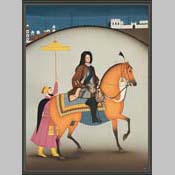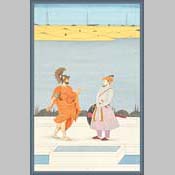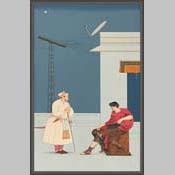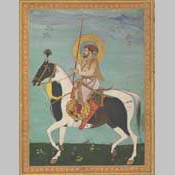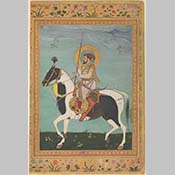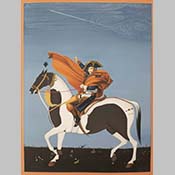Farhat Ali (b. 1988) has once again done it. He has astonished his patrons through his mesmerizing art that juxtaposes Mughal era figures with its Roman counterparts. An East meets West!
The 15 paintings in the collection were sold out days before the show opened and are executed in fine detail. The tongue in cheek display of transmission lines and communications towers as backdrops, and solar panels and dish antennas on the roof tops of classic Mughal period marble buildings create ingenious compositions to contemporize traditional imagery and mood.
The Untitled 13 painting executed in gouache on wasli shows Khan Dawran who served as a general during Shah Jahan’s reign (1628-1658), in a serious conversation with Caesar Augustus (63 BC – 14 AD), the founder of the Roman Empire, sitting in a pensive mood on his throne. Farhat has researched well the furniture design and mastered the drapery and attire of the time. Attention to detail is at its utmost with the exquisite rendering of the hands and the feet of Caesar Augustus, to the fine woodworking of the chair to bring out the sculptural quality, shine and patina. The not so noticeable, yet incredibly fine shadows, which only a master artist can do.
Farhat Ali’s fine lines, shading and padakht technique as eminent from the beard of Khan Dawran is par excellence.
This is one of the great imperial portraits of Shah Jahan’s reign, commissioned soon after his accession. Payag introduced a shallow depth of field occupied by a stallion and its imperial rider and sprinkled it with beautifully observed wildflowers. Shah Jahan wears a white Jama, gold sash (patka), and jewel encrusted weapons, impeccably rendered. A radiant gold nimbus frames his portrait in profile, adding to the opulence of this representation of imperial power. This is idealized portraiture, filtered through a culture in which heightened aesthetic refinement was an expression of the imperial self.
Incidentally this painting was also on the cover of the catalogue of the seminal exhibition titled “Wonder of the Age” at the Met held in 2011. For the very first time an exhibition of manuscript paintings from South Asia and in particular Mughal miniature paintings were curated based on the artists and where possible the works could be attributed to them through research and analysis. 110 works of the most eminent artists from the royal ateliers and courts during the Mughal golden period 1575-1650, such as Abd al-Samad, Manohar, Farrukh Beg, Keshav Das, Aqa Riza, Abu’l Hasan, Abid, Mansur, Balchand and Payag, and their masterpieces were presented and analyzed in detail. The same exhibition also covered late Mughal paintings and the renaissance of the Hindu courts from 1650-1730, and then the Mughal afterglow and the later court styles that emanated from the Pahari region and Rajasthan from 1730-1825. Ruknuddin, Bhavanidas, Mir Kalan Khan, Chitarman, Mir Kalan Khan, Manaku, Nainsukh, Purkhu, Bagra and Chokha are some notable names from that period. Sunset of the court paintings was from 1825-1900 just as photography was coming to India, a period dominated by artists like Tara, Shivalal and Mohanlal, Ghulam Ali Khan doing Company paintings for British representatives. The largest and most impressive group of such paintings was commissioned by the Scottish brothers Willam and James Fraser.
Farhat Ali began his career as a signboard painter in the interior of Sindh and after working for 10 years as a commercial painter, he pursued his studies at the Centre of Excellence in Art & Design, Jamshoro and then subsequently went on to join the prestigious National College of Arts in Lahore. He graduated with distinction in 2015 and has to his credit 4 solo shows in addition to several group exhibitions in various galleries and art fairs in India, Pakistan, Europe and USA.
Some of his critics give him 10 out of 10 in skills and a 7 out of 10 for creativity and innovation, an area he continues to explore and develop. He is a gifted artist and some feel that he has the skills of master Mughal court artists like Mansur and Payag. Some may also find him to be repeating his subject matter, but so did Mansur and Payag.
When I asked Murlidhar Dawani – a deeply passionate art collector – what his opinion was about Farhat Ali’s latest work being exhibited at the Sanat Art Gallery, he had the following to say “the beauty of Farhat’s work is his playfulness. He is a mesmerizing and bold storyteller who manages to seamlessly blend together characters, objects across space and time that normally would not fit together in a unique manner that never ceases to surprise and delight its audience.”
Farhat Ali is an artist to watch in the future as he experiments and explores, bringing in new ideas and going beyond the borders while staying withing the realm of fine detail to come up with new ways of seeing neo-miniature paintings.
About the Author
Ali Adil Khan is the founder and director of South Asian Gallery of Art (SAGA) and the Shehla and Adil Giving for Art Foundation (SAGA Foundation) in Toronto, Canada. He is an art critic, curator, writer and collector.CAPTION
Untitled 13, gouache on wasli (detail)Untitled 7, gouache on wasli, 2022, 38x29 inches
Untitled 7 (Napolean riding a stallion) is arguably Farhat Ali’s best work of his lifetime. It is the “Hasel-e-Numaish” (best of the best in the exhibition). A recreation of Payag’s Shah Jahan riding a stallion from the Kevorkian Album in the Metropolitan Museum of Art, New York.
Untitled 13, gouache on wasli, 2022 (20x13 inches)
Shah Jahan riding a stallion by Payag, Opaque water colour on paper, 11.5 x 8.25 in, circa 1628
UNTITLED - 10, Gouache on wasli, 27 x 20 inches


